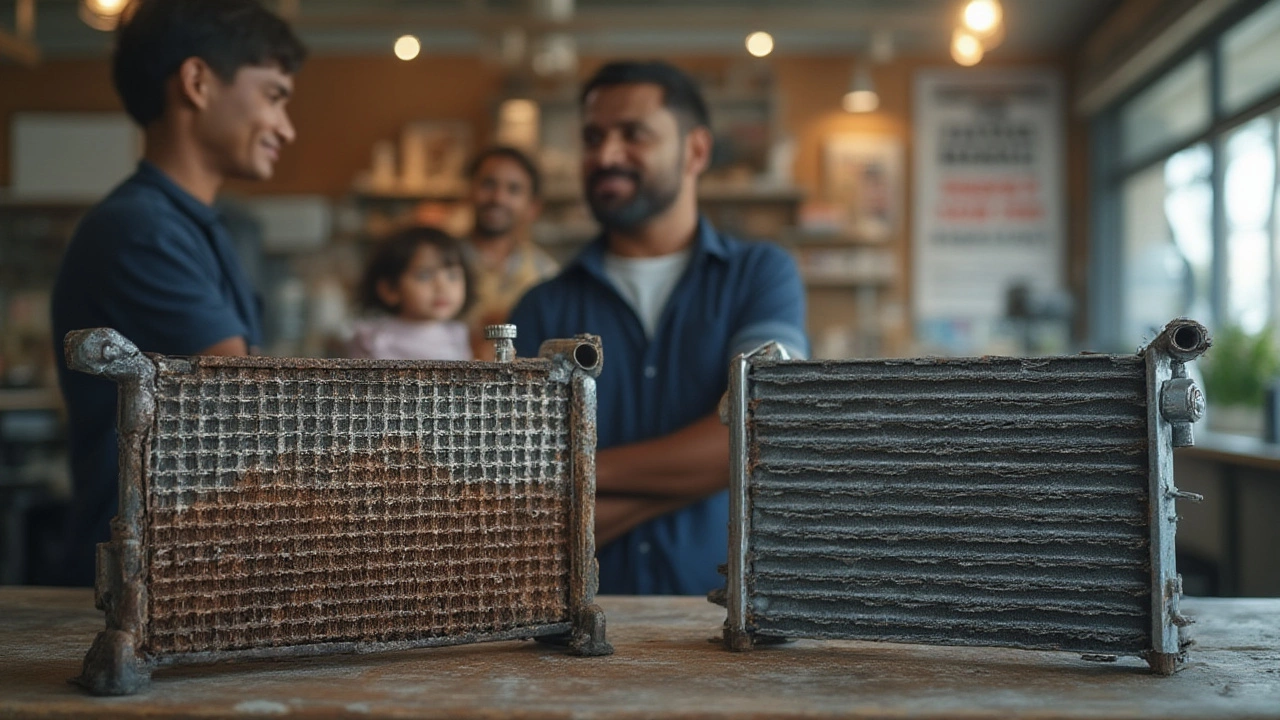 Jul, 8 2025
Jul, 8 2025
You’re flying down the QEW on your way to Toronto, traffic’s light for once, and suddenly you see that temperature gauge shoot up. The radiator just made its presence loudly known—and it’s never about good news. Most folks get stuck here: do you try to fix the radiator, or just rip out the old one and put in something new? It’s not just about the immediate bill in front of you—there's a web of questions about car age, repair guarantees, hidden issues, and long-term value.
How Radiators Work and Why Repairs Matter
Radiators are the unsung heroes of your vehicle’s cooling system. They circulate coolant, keeping your engine from cooking itself. A working radiator turns that deathly heat from driving into… well, harmless warm air. But a cracked, corroded, or clogged radiator can turn an average day into a call for a tow truck, ruining plans fast.
It helps to know your enemy: most modern radiators are made from lightweight aluminum or plastic, designed for efficiency but not always built to last. That’s actually a big deal—plastic tanks on the ends of most radiators can degrade over the years, especially in climates that swing wildly between winter freezes and hot Ontario summers. If yours springs a leak, you’re losing coolant and risking major engine damage. Fast leaks can kill an engine—sometimes in minutes.
Repair isn’t always so simple. Small things like minor cracks or loose hoses are sometimes manageable, but corrosion inside the core or tank is usually a sign of bigger trouble brewing. The trickiest bit? Some leaks hide in spots impossible to see without taking out the radiator. That means a fast patch may not be much of a fix—think bandaid over a leaky dam.
Ignoring radiator problems will leave you with either a dead car or a wild engine repair bill. Seized engines from overheating won’t be cheered up by a simple radiator fix. According to CAA, overheating is one of the top three causes of highway breakdowns in summer.
The Real Costs: Comparing Repair to Replacement
Money is usually the main factor for most people—nobody wants to drop four figures if a $90 fix will work. Here’s where the reality check comes in. Basic repairs—like patching a pinhole leak with a quality epoxy kit—run about $50–$150, if you do it yourself and know what you’re doing. Labor is where things ramp up, with a mechanic charging anywhere from $100–$400 depending on location and the model of the car. Sometimes they suggest flushing the cooling system, adding another $70–$120.
More complex repairs—think replacing cracked plastic tanks or old metal cores—usually cost more. Professional radiator shops, which are getting rarer in places like Hamilton, might quote anywhere between $250 and $600 for a thorough overhaul. But the catch: Once a radiator has started failing in several spots, more issues pop up after the first fix. Re-core jobs are basically a temporary revival for an old part.
| Service | DIY Cost (CAD) | Mechanic Cost (CAD) | Typical Lifespan After Repair |
|---|---|---|---|
| Pinhole Leak Patch | $50–$80 | $150–$250 | 2–12 months |
| Tank Seal Replacement | N/A | $250–$500 | 1–3 years |
| Radiator Replacement | $150–$400 | $450–$1100 | 5–10 years |
Now, a new radiator for most compact or mid-sized cars in Canada sells for between $150–$400 (not including install). Larger vehicles like trucks or luxury sedans can see prices from $400 up to $1000 or more. Labor for installation? Usually about $200–$400. In Hamilton, shops in 2025 are quoting about $700–$1200 total for new radiator installs on sedans, and that usually comes with at least a one-year warranty on parts. The real number depends on how hard your radiator is to get at—cars with cramped engines (like some BMWs and Minis) cost more than a big old Ford pickup.
At first glance, repairs look cheaper. But each repair only really buys time. In cars older than five or six years, the original radiator is likely halfway to retirement. Multiple rounds of repairs might cost as much—or more—than just biting the bullet and purchasing a new one. Plus, trust in a repair doesn’t always last. There’s nothing fun about paying $300 to seal a tank, then paying the same again for another hidden crack two months later.

Hidden Costs and Value Beyond the Bill
It’d be easy if it was just about the check you write today. Problems come when you look further down the road. For starters, repairing a failing radiator sometimes means you miss deeper problems. Imagine a cracked tank caused by ongoing overheating due to a blocked core—the immediate crack is fixed, but the block remains, just waiting to cause more trouble later. When mechanics see a corroded or heavily rusted unit, many suggest straight-up replacement for this very reason.
Warranty is a big deal. Most new radiators come with a standard one-year, sometimes even two- or three-year warranty. Repairs, unless they’re done at a specialist shop, usually don’t carry much guarantee beyond “if it leaks right away, bring it back.” You might find it funny (or infuriating), but manufacturers expect radiators to last at least 5–10 years—that’s the stated design spec for most OEM parts.
Another sneaky cost: repeated overheats. One breakdown (with a tow) in Hamilton hovers around $120–$150 just to get you off the road, not counting any emergency garage rates. One failed repair that leaves you stuck at the side of Centennial Parkway can easily gobble up any cash you meant to save by going cheap. It stings especially hard if you like road trips—nothing ruins a Muskoka weekend faster than a failed cooling system.
Then there’s fuel efficiency and emissions. A shaky repair can lead to coolant loss, and engines that run hot burn fuel poorly, sputtering and pushing out extra emissions. Transport Canada has highlighted how cooling system issues—even mild overheating—create more pollution and wasted gas. That means extra bucks at the pump and a quicker trip to emissions testing headaches.
If you plan to sell or trade your vehicle, a recent radiator replacement is a confidence booster for buyers. Nobody wants to inherit a “fixed” cooling system that might snap again. As car prices soar in Canada (the new average for a sedan is over $40,000), folks are looking for used options, but even these buyers want proof that main systems are reliable.
When Does Repair Make Sense—and When Does Replacement Win?
Sometimes you can win with a repair, absolutely. If you have a nearly new radiator, or the damage is minor (a single stone hit or a worn hose), patching things up is smart. Radiator repair is a solid move for classic cars, rare vehicles, or spots where a direct-replacement doesn’t exist. The shop might fabricate a new core or work their magic on a vintage part you just can’t replace for love or money.
But if you’re on your third patch, or cracking plastic tanks have started, you’re running out of rope. Most mechanics in Hamilton say if your radiator is older than seven years or has a pattern of issues, just swap it. Modern replacements aren’t made of fairy dust, but they are cheaper and more reliable than playing whack-a-mole with old leaks. And with warranty coverage, they often come out ahead when you factor in downtime, future breakdown risk, and peace of mind.
The one big exception: if the car is nearing the end of its life anyway—or you’re planning to scrap it in the next year—why pour more cash in? Cheap repair might be the only logical route. But for anyone counting on their vehicle for everyday travel, especially commutes into rough winter weather, replacement is the more reliable bet.
- Get a quote for both options, not just one. Don’t take a single shop’s word.
- If you go with repair, ask about hidden corrosion or blockages—make sure your “fix” isn’t just a cover-up.
- For DIY folks: flush the system and check hoses, thermostats, and coolant caps while you’re at it. Hidden problems upstream kill new radiators fast.
- Consider the age and mileage of your car. A 2015 Honda Civic with a new radiator might last until the next round of teenagers learn to drive.
Remember—the true cost isn’t just about the bill for parts and hours in the shop. It’s the headache savings, too. And when you’re gunning down the Red Hill Expressway through Hamilton in January, you don’t want to gamble with a key part of your engine’s health. If the radiator’s showing its age and you’re seeing repair bills add up, replacement almost always pays off in cash—and in stress levels.